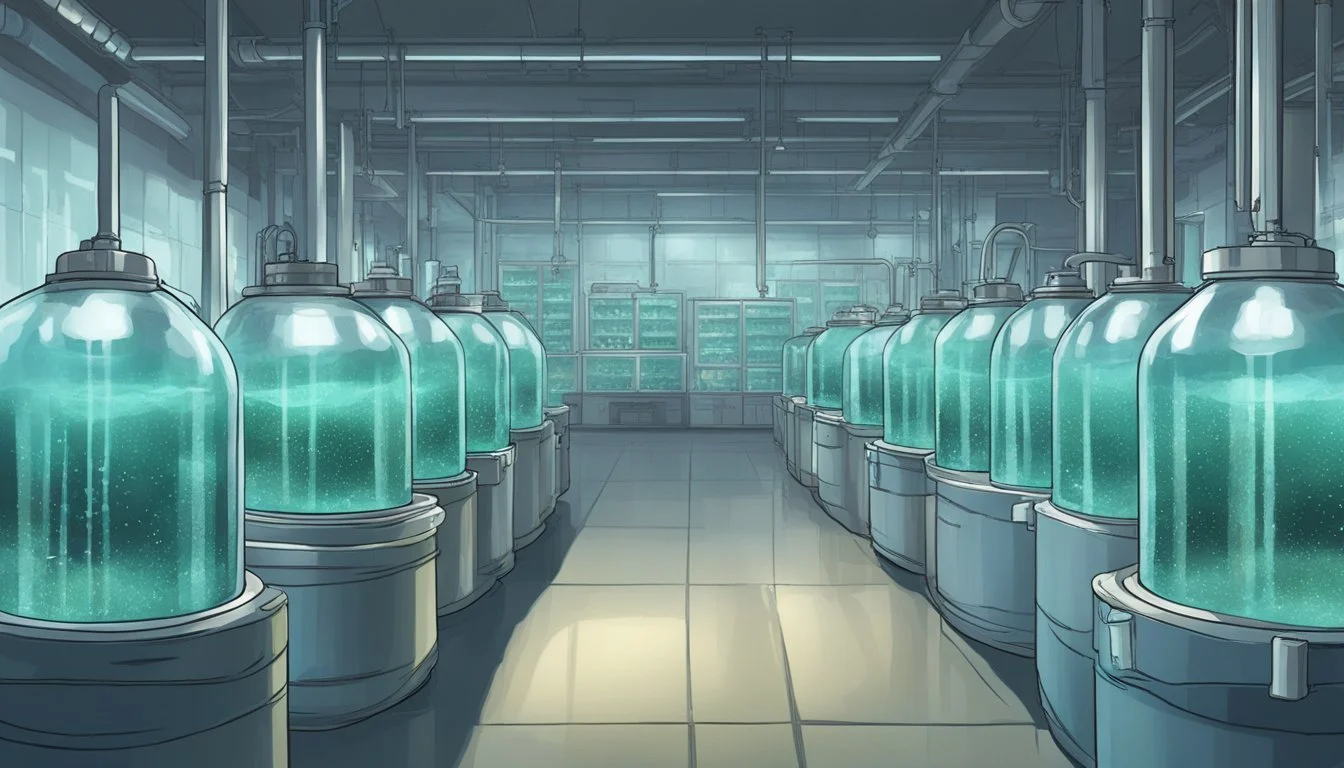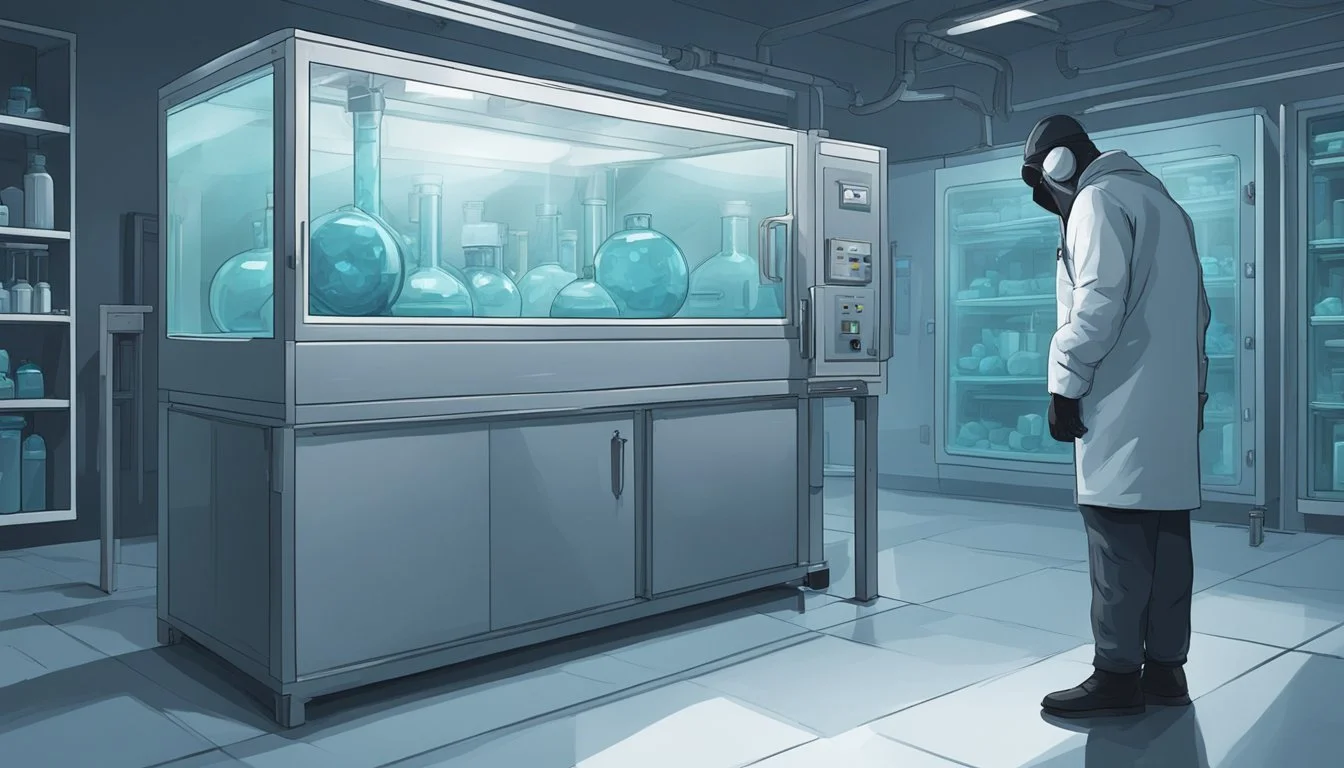12 Disturbing Documentaries on Cryonics Fraud and Body Snatching
Unveiling the Dark Side of Preservation Promises
Documentaries have the power to expose dark truths and shed light on disturbing realities. While many focus on true crime or historical events, some venture into more unconventional territory, revealing shocking practices in science and medicine.
This article explores twelve documentaries that delve into the controversial worlds of cryonics fraud and body snatching. These films uncover illegal activities surrounding human remains and frozen corpses, exposing unethical practices that blur the lines between scientific advancement and criminal exploitation. Viewers will gain insight into a shadowy underworld where bodies become commodities and the promise of eternal life leads to deception.
1) Frozen Faith: The Cryonics Conspiracy
"Frozen Faith: Cryonics and the Quest to Cheat Death" exposes the controversial world of cryonics. This documentary explores the beliefs and practices of cryonicists, who hope to be revived after death through freezing technology.
The film delves into the Cryonics Institute, where bodies are stored in liquid nitrogen at -196 degrees Celsius. It examines the case of Robert Ettinger, a prominent figure in the cryonics movement who died in 2011 and had his body preserved.
Critics argue that cryonics is pseudoscience with little chance of success. The documentary highlights the ethical and scientific debates surrounding the practice, including concerns about body snatching and fraud.
The film also touches on the financial aspects of cryonics. Some individuals spend significant sums, like the Sydney man who paid $112,000 for cryogenic freezing, despite skepticism from the scientific community.
"Frozen Faith" raises questions about the impact of cryonics on families. It showcases the emotional and practical challenges faced by loved ones when dealing with a family member's desire for cryopreservation.
2) Stolen Futures: The Cryonics Scandal
The cryonics industry faced a major scandal in the early 2000s when several facilities were found to be engaging in fraudulent practices. Investigators uncovered evidence of body snatching, where deceased individuals were cryopreserved without proper consent from family members.
Some cryonics companies were accused of making false promises to terminally ill patients, convincing them to sign over their life savings for a chance at future revival. Critics argued these vulnerable individuals were exploited for profit with little scientific basis.
Allegations also emerged of substandard preservation practices at certain cryonics facilities. Former employees claimed bodies were improperly stored, leading to tissue damage that would likely prevent any future resuscitation attempts.
The scandal shook public trust in the cryonics field. It highlighted the lack of regulation and oversight in an industry dealing with human remains and end-of-life decisions. Several facilities were shut down, and others faced lawsuits from families of preserved individuals.
While some cryonics advocates maintained the field's potential, the scandal raised serious ethical questions about the treatment of the deceased and the marketing of unproven technologies to the desperate and dying.
3) Chilling Truth: Cryonics Exposed
Cryonics, the practice of freezing human bodies after death, has long been a subject of controversy. Despite its sci-fi allure, the scientific community largely regards it as pseudoscience.
The Society for Cryobiology banned its members from involvement in cryonics during the 1980s. A former president of the organization even likened the field to fraud rather than legitimate scientific practice.
Cryopreservation of cells and organs is a valid scientific endeavor. However, the preservation of entire human bodies remains highly problematic and unproven.
The process of freezing a body causes significant damage at the cellular level. This damage makes the prospect of future revival extremely unlikely with current technology.
Many experts argue that those who sell cryonic services are exploiting people's fear of death. These companies often make promises that have no scientific basis.
The high costs associated with cryonic preservation raise ethical questions. Critics argue that the money could be better spent on proven medical treatments or research.
Despite the skepticism, some individuals continue to pursue cryonic preservation. In 2024, an Australian man became the first person in his country to have his body cryogenically frozen.
4) Suspended Illusions: Fraud in Cryonics
Cryonics promises the possibility of future revival, but this field is rife with fraudulent practices and unethical behavior. Some cryonics companies have been accused of making false claims about their preservation techniques and success rates.
Investigations have uncovered cases of bodies improperly stored or allowed to thaw due to equipment failures. In other instances, promised preservation procedures were not actually carried out, despite families paying large sums of money.
Financial fraud is also a concern in the cryonics industry. Some organizations have misused funds intended for long-term patient care and facility maintenance. This puts the viability of preserved bodies at risk.
Regulatory oversight of cryonics is limited, allowing unscrupulous operators to take advantage of people's hopes and fears about death. Critics argue that cryonics companies often oversell the likelihood of successful revival.
While some cryonics practitioners are well-intentioned, the lack of scientific evidence for human cryopreservation leaves the field open to exploitation. Carefully evaluating cryonics claims and companies is crucial for those considering this controversial option.
5) Bodies on Ice: The Cryonics Deception
Cryonics, the practice of freezing human bodies after death in hopes of future revival, has been fraught with controversy and failure. Despite its pseudoscientific nature, some individuals continue to invest substantial sums in this unproven technology.
The documentary "Bodies on Ice" exposes the grim reality behind cryonics facilities. It reveals that many bodies preserved before 1973 have deteriorated beyond recognition, with only one remaining intact.
The film investigates the case of the Cryonics Society of California, where a Dewar container failure led to the decomposition of multiple bodies. The resulting fluids had to be scraped out, a far cry from the pristine preservation promised to clients.
Interviews with former employees shed light on the technical challenges and ethical dilemmas faced by cryonics companies. The documentary also explores the financial motivations driving these organizations, questioning whether they exploit the fears and hopes of the terminally ill.
"Bodies on Ice" examines the legal and regulatory vacuum surrounding cryonics, allowing companies to operate with minimal oversight. It challenges viewers to consider the implications of pursuing immortality through questionable means.
6) Harvest of Bodies: Dark Side of Cryonics
Cryonics, the practice of freezing human bodies for potential future revival, has a dark underbelly rarely discussed openly. Some unscrupulous operators have exploited people's fear of death for financial gain.
Cases have emerged of cryonics companies harvesting bodies without proper consent or legal authorization. Families have reported loved ones' remains being taken under dubious circumstances.
The high costs associated with cryopreservation create incentives for fraud. Some facilities have been accused of cutting corners on preservation methods while still charging premium prices.
There are also concerns about the long-term viability of cryonics companies. If a facility shuts down or faces financial troubles, preserved bodies may be at risk of improper storage or disposal.
Critics argue the entire field preys on vulnerable people's hopes for immortality. They contend cryonics companies make unrealistic promises about future revival technology that may never materialize.
Regulatory oversight of cryonics remains limited in most jurisdictions. This lack of scrutiny has allowed questionable practices to persist in some corners of the industry.
7) Preserved Lies: A Cryonics Chronicle
"Preserved Lies: A Cryonics Chronicle" exposes the dark underbelly of the cryonics industry. This documentary follows the stories of several individuals who invested their life savings in cryopreservation, hoping for a second chance at life.
The film reveals shocking instances of fraud and mismanagement within cryonics facilities. Interviews with former employees shed light on inadequate preservation techniques and cost-cutting measures that compromise the integrity of stored bodies.
Families of the deceased share their heartbreak upon discovering their loved ones' remains were not properly maintained. The documentary also explores legal battles between cryonics companies and clients' estates.
Experts in the field discuss the scientific limitations of current cryopreservation methods. They explain why the promise of future revival remains highly improbable with today's technology.
The film examines the ethical implications of selling false hope to terminally ill patients. It questions whether cryonics companies exploit vulnerable individuals facing mortality.
"Preserved Lies" serves as a cautionary tale about the risks of putting faith in unproven scientific claims. It challenges viewers to consider the human cost of pursuing immortality through questionable means.
8) Cryonics Hoax: Anatomy of Deceit
Cryonics, the practice of freezing human bodies after death in hopes of future revival, has attracted both believers and skeptics. Some cryonics companies have been accused of exploiting people's fear of death for financial gain.
These organizations often make grandiose promises about the potential for reanimation, despite a lack of scientific evidence. They may use pseudoscientific jargon to create an illusion of legitimacy and technological advancement.
Marketing tactics can include emotional appeals and pressure to make quick decisions. Some companies have been known to target terminally ill patients or their families when they are most vulnerable.
Financial arrangements for cryopreservation can be complex and costly. Critics argue that the funds collected are rarely sufficient for the long-term care and hypothetical revival process promised.
Investigations have revealed instances of mismanagement and neglect in some cryonics facilities. Reports of improperly stored bodies and inadequate liquid nitrogen supplies have raised serious ethical concerns.
The anatomy of cryonics deceit often involves a mix of scientific misrepresentation, emotional manipulation, and financial mismanagement. This combination can lead to devastating consequences for those who invest their hopes and resources in an unproven technology.
9) Broken Promises: The Cryonics Betrayal
The documentary "Broken Promises: The Cryonics Betrayal" exposes the dark underbelly of the cryonics industry. It follows the stories of families who entrusted their loved ones' bodies to cryonics facilities, only to discover shocking negligence and broken agreements.
The film reveals instances where bodies were improperly preserved or even discarded. In one case, a cryonics company went bankrupt, leaving frozen remains in limbo. Another segment explores how some facilities cut corners on preservation methods to save costs.
Interviews with former cryonics employees shed light on unethical practices and false promises made to desperate clients. The documentary also examines legal battles fought by families seeking justice for their deceased relatives.
Experts weigh in on the scientific implausibility of successful reanimation, contrasting with the hopeful claims made by cryonics proponents. The film raises questions about the ethics of an industry built on unproven technology and vulnerable people's fears of death.
"Broken Promises" serves as a cautionary tale about the risks of entrusting one's afterlife to an unregulated industry. It challenges viewers to consider the human cost of pursuing immortality through questionable means.
10) The Cryonics Con: Chilling Fraud Revealed
This documentary exposes the dark underbelly of the cryonics industry, where unscrupulous operators prey on people's hopes for immortality. It follows the story of a prominent cryonics company that promised to freeze and preserve clients' bodies for future revival.
Investigators uncovered shocking evidence that the company was not properly storing bodies as claimed. Instead of high-tech preservation, remains were found improperly stored in ordinary freezers or even left to decompose.
The film features interviews with former employees who detail how the company cut corners and misled clients. Financial records reveal that millions in client funds were misappropriated for personal use by the company's executives.
Heartbroken family members share their experiences of discovering their loved ones' remains were not preserved as promised. The documentary raises serious ethical questions about the cryonics industry and the exploitation of people's fear of death.
Experts weigh in on the scientific implausibility of the claims made by cryonics companies. The film serves as a cautionary tale about the dangers of unproven and unregulated medical promises.
11) Human Popsicles: Scam or Science?
Cryonics, the practice of freezing human bodies for potential future revival, straddles the line between scientific pursuit and controversial speculation. Proponents believe it offers a chance at extended life, while critics argue it's based on unproven theories.
The process involves cooling bodies to extremely low temperatures using liquid nitrogen. Patients are stored upside down to prioritize brain preservation. However, current cryopreservation techniques likely cause irreversible damage to cellular structures.
No human has ever been successfully revived from cryopreservation. The scientific community largely views cryonics as pseudoscience due to the lack of evidence supporting its feasibility.
Cryonics companies continue to operate, charging substantial fees for their services. Some argue these businesses exploit people's fear of death and desire for immortality.
While cryopreservation has legitimate applications in preserving cells and organs for research, its use for entire human bodies remains highly experimental. The gap between current capabilities and the technology required for revival is vast.
As it stands, cryonics occupies a grey area between scientific aspiration and speculative enterprise. Its ultimate viability remains uncertain, leaving many to question whether it's a potential breakthrough or an elaborate deception.
12) Corpse Commerce: The Cryonics Economy
The cryonics industry operates on the fringes of traditional medicine and funerary practices. Companies offer services to preserve bodies or brains after death, with the hope of future revival.
Costs for cryopreservation can range from $28,000 to $200,000, depending on the provider and extent of preservation. Some individuals pay upfront, while others use life insurance policies to cover expenses.
Storage facilities require ongoing maintenance and liquid nitrogen replenishment. This creates a long-term financial burden for cryonics organizations, which must ensure funding for potentially centuries of care.
The industry faces skepticism from the scientific community and legal challenges regarding the definition of death. Despite this, some wealthy individuals and futurists continue to invest in cryonics services.
Recent years have seen increased interest in cryopreservation, partly due to the COVID-19 pandemic. However, the total number of cryopreserved individuals worldwide remains relatively small, with estimates around 500 people.
History of Cryonics Fraud
Cryonics fraud has plagued the field since its inception, with numerous scandals involving financial misconduct and improper handling of human remains. Regulatory challenges have further complicated efforts to legitimize and oversee cryopreservation practices.
Early Scandals and Misconduct
The first major cryonics scandal erupted in 1979 when it was discovered that nine bodies at the Chatsworth facility in California had thawed due to inadequate funding and mismanagement. This incident shook public confidence in cryonics organizations and raised serious ethical concerns.
In 1987, the Alcor Life Extension Foundation faced scrutiny when they cryopreserved the severed head of a deceased member without proper consent. This case highlighted the legal ambiguities surrounding cryonics procedures.
Financial improprieties also plagued early cryonics ventures. Several companies were accused of misusing client funds intended for long-term care and preservation. These incidents led to increased skepticism from both the scientific community and the general public.
Regulatory Challenges
The lack of clear regulations has contributed to ongoing issues in the cryonics industry. Many jurisdictions do not have specific laws governing cryopreservation, leaving a legal gray area.
Attempts to classify cryonics as a medical procedure have been largely unsuccessful. This has made it difficult to establish standards for training, equipment, and facility maintenance.
Some cryonics organizations have faced accusations of operating as unregulated funeral homes. This has led to conflicts with state licensing boards and health departments.
Efforts to create voluntary industry standards have had limited success. The absence of formal oversight continues to raise concerns about potential fraud and misconduct in cryonics practices.
Case Studies of Body Snatching
Body snatching for cryonics has led to several infamous incidents and legal repercussions. These cases highlight ethical concerns and legal gray areas surrounding cryopreservation practices.
Infamous Incidents
In 1987, the Alcor Life Extension Foundation faced allegations of illegal body acquisition. They were accused of prematurely declaring a patient dead to expedite cryopreservation. The case sparked public outrage and scrutiny of cryonics practices.
A 2002 incident involved a Michigan cryonics company. They allegedly removed a deceased woman's head without proper authorization, intending to preserve only her brain. Family members were horrified upon discovering the body's condition.
In 2018, a Russian cryonics firm was investigated for obtaining bodies through questionable means. Authorities suspected collusion with morgue employees to access recently deceased individuals without consent.
Legal Consequences
Body snatching for cryonics has resulted in criminal charges and civil lawsuits. Perpetrators have faced accusations of abuse of a corpse, fraud, and conspiracy.
Some cases led to stricter regulations on cryonics facilities. California, for example, now requires cryonics companies to register as cemetery operators and follow specific protocols for body handling.
Families of victims have sued cryonics organizations for emotional distress and unauthorized body modification. These lawsuits often cite lack of informed consent and violation of burial rights.
Legal experts debate the status of cryopreserved bodies. This ambiguity complicates prosecution efforts and highlights the need for clearer legislation surrounding cryonics practices.
The Ethical Debate Surrounding Cryonics
Cryonics raises complex moral questions about life, death, and the nature of consciousness. It sparks heated debates over resource allocation, consent, and scientific validity. Public attitudes toward cryopreservation remain skeptical, with many viewing it as a fringe practice.
Moral Implications
Cryonics challenges traditional definitions of death and personhood. Proponents argue it offers a chance at extended life and future medical advances. Critics question if reanimation is truly possible or desirable. The use of resources for an unproven technology when many lack basic healthcare is contentious.
Issues of informed consent arise, especially for minors or incapacitated individuals. Some worry cryonics could lead to exploitation of vulnerable people. The potential psychological impact on loved ones who must say goodbye, yet hold onto hope, is also debated.
Public Perception
Most view cryonics with skepticism or outright dismissal. Media portrayals often sensationalize or mock the practice. Common concerns include:
Scientific feasibility
High costs
Possible scams or false promises
Disruption of natural life cycles
Some see cryonics as a misguided attempt to cheat death. Others view it as an innovative medical technology. Religious groups often object on spiritual grounds. A small but dedicated community of supporters continues to advocate for cryonics research and acceptance.












